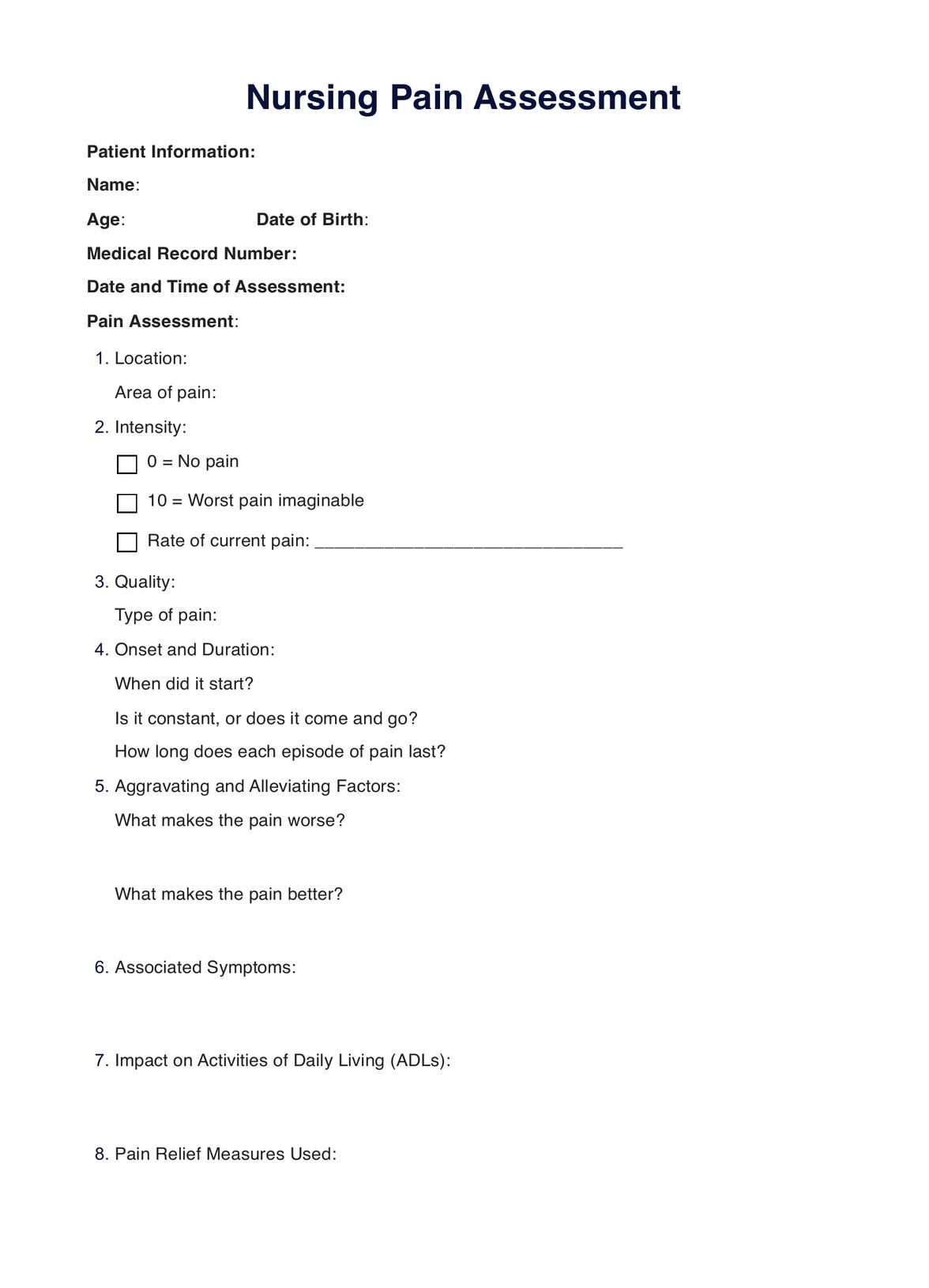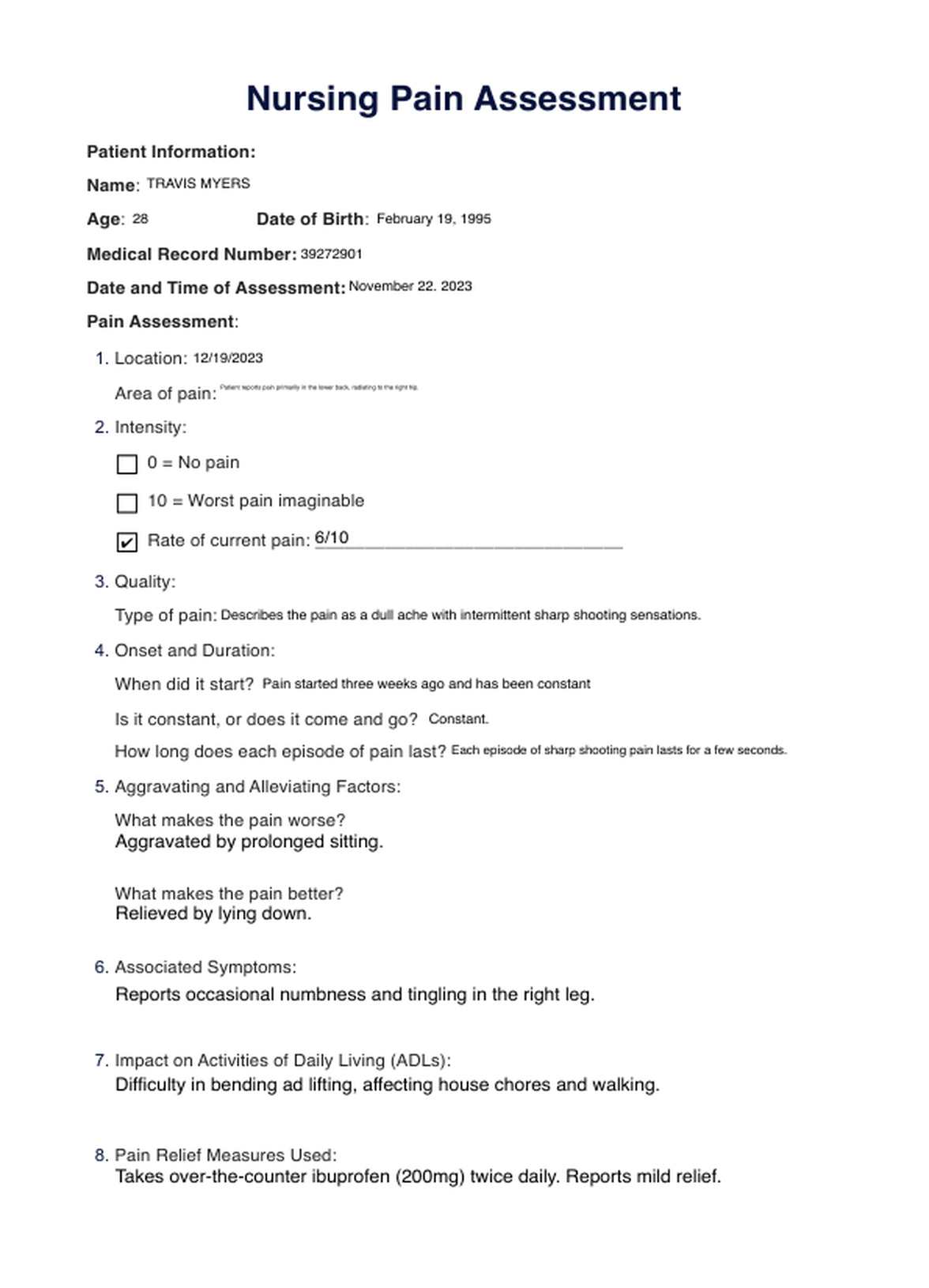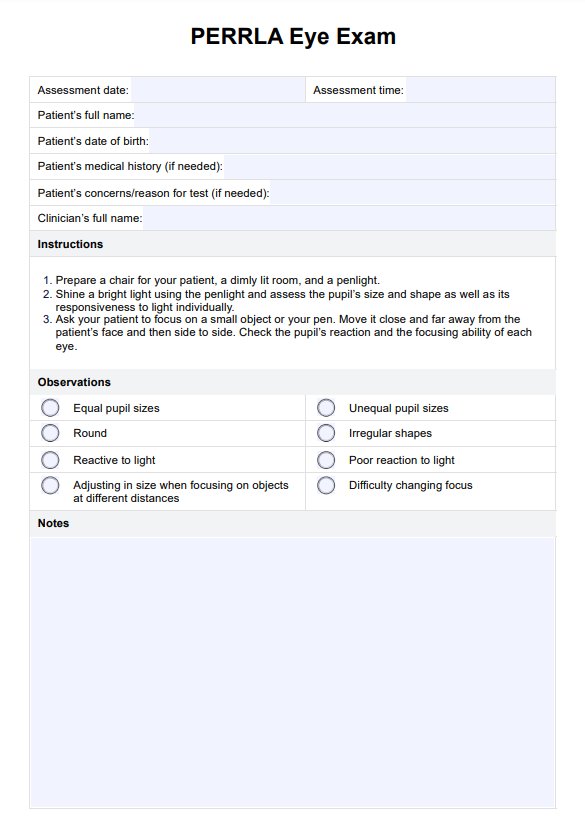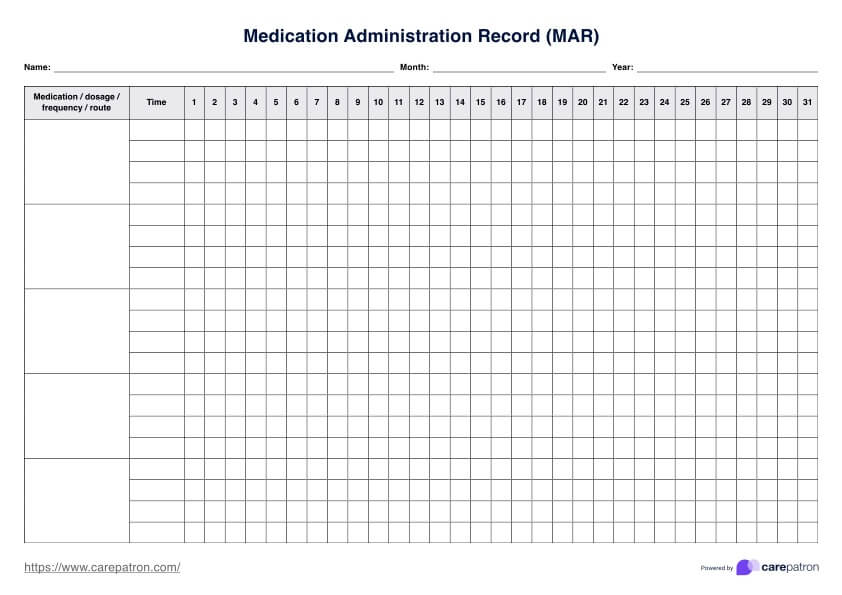Nursing Pain Assessment Template
Learn about the importance of nursing pain assessment and how it is carried out in healthcare settings. Download a free PDF example to understand the process better.


What are nursing pain assessments?
A fundamental aspect of patient care, nursing pain assessments play a pivotal role in ensuring the well-being and comfort of individuals experiencing varying degrees of pain. These assessments involve systematic evaluations of a patient's pain experience, encompassing pain intensity, duration, and the impact on daily activities.
Nursing care pain assessments are crucial for several reasons. They provide healthcare professionals with valuable insights into the nature and extent of a patient's pain, facilitating the development of personalized and optimal pain management plans. Recognizing and addressing pain promptly not only contributes to enhanced patient comfort but also aids in the prevention of complications associated with untreated pain, such as anxiety, sleep disturbances, and compromised overall well-being.
The roots of nursing pain assessments can be traced back to the growing understanding of pain as a multidimensional phenomenon. Historically, pain was often overlooked or undertreated, but advancements in medical knowledge and a shift towards patient-centered care have elevated the importance of pain assessment in nursing practice.
In simpler terms, nursing pain assessments serve as the cornerstone for developing compassionate and individualized care plans, ensuring that patients receive optimal support in managing their pain and achieving a better quality of life.
Nursing Pain Assessment Template
Nursing Pain Assessment Template Example
Goals and outcomes of this assessment
Nursing care pain assessment tools are instrumental in achieving specific goals that contribute to enhanced patient well-being and improved pain management. By systematically evaluating various aspects of pain, healthcare professionals aim to attain critical outcomes that guide the development of personalized care plans.
1. Assessing acute and severe pain
The primary goal of a thorough pain assessment is to systematically evaluate and quantify acute and severe pain. By understanding the nature and intensity of pain, healthcare providers can promptly address immediate needs, facilitating quicker relief and preventing complications associated with undertreated pain.
2. Comprehensive pain management
Goal: To develop comprehensive pain management plans tailored to the individual needs of the patient.
Nursing assessments aim to identify the most effective strategies for managing pain, considering both pharmacological and non-pharmacological interventions. This holistic approach ensures that the patient receives optimal relief while minimizing the risk of side effects or complications.
3. Quantifying pain intensity
Goal: To accurately measure and document the intensity of pain experienced by the patient.
Utilizing standardized scales, such as numerical or visual analog scales, enables healthcare professionals to quantify pain intensity. This quantitative data serves as a crucial benchmark for assessing the effectiveness of interventions over time and adjusting treatment plans accordingly.
4. Addressing chronic pain
Goal: To recognize and assess chronic pain conditions for long-term management.
Chronic pain requires a different approach compared to acute pain. Nursing care pain assessment are designed to identify persistent pain conditions, allowing healthcare providers to develop sustainable and effective long-term management strategies that improve the patient's quality of life.
5. Facilitating pain relief
Goal: To implement timely interventions that provide effective pain relief.
The ultimate outcome of a nursing care pain assessment tools is to initiate interventions that alleviate pain and improve the patient's comfort. This may involve adjusting medications, incorporating non-pharmacological approaches, or collaborating with other healthcare professionals to address the root causes of pain.
In summary, the goals and outcomes of nursing care pain assessments revolve around understanding the unique aspects of each patient's pain experience.
By systematically assessing acute and severe pain, developing comprehensive management plans, quantifying pain intensity, addressing chronic pain, and facilitating timely relief, healthcare professionals can ensure that patients receive the most appropriate and physical therapy for their pain-related needs.
Pain scales
Pain assessment in nursing care relies on the use of standardized pain scales, which provide a systematic and objective way to evaluate a patient's pain experience.
These scales help healthcare professionals quantify pain intensity and guide effective pain management strategies.
One of the most common scales is the Wong-Baker FACES scale, but there are more scales used by nurses, doctors, and medical practitioners to assess pain. These include:
Numeric rating scale (NRS)
The Numeric Rating Scale, ranging from 0 to 10, allows patients to rate their pain on a numerical scale. Nurses use this to assess pain from zero. Zero represents no pain, while ten indicates the worst possible pain. This scale is versatile and commonly used in both acute and chronic pain management settings. Healthcare providers can quickly assess changes in pain intensity over time, guiding adjustments in pain medication and other interventions.
Visual analog scale (VAS)
The Visual Analog Scale is a continuous line upon which patients mark their level of pain. The distance from the starting point to the patient's mark indicates the pain intensity. VAS is effective in assessing pain intensity and is particularly useful for patients who may find it challenging to express their pain verbally.
Wong-baker FACES pain rating scale
The FACES Scale, also known as the Wong-Baker FACES Pain Rating Scale, is widely used in nursing care pain assessments. This visual analog scale employs a series of faces displaying different expressions, ranging from a happy face indicating no pain to a distressed face representing maximum pain intensity.
The Wong-Baker FACES Scale is particularly relevant in various healthcare settings, including pediatric care and instances where language barriers may exist. It is a valuable tool for assessing pain intensity, allowing patients to express their pain levels by pointing to the face that best represents their experience.
Neuropathic pain scales
For patients experiencing neuropathic pain, specialized scales like the Neuropathic Pain Scale (NPS) or the Douleur Neuropathique en 4 Questions (DN4) may be employed. These scales consider specific characteristics of this type of pain, such as burning or tingling sensations, helping healthcare providers tailor interventions that target the underlying mechanisms of pain.
Acute pain management scales
In acute care settings, scales like the Behavioral Pain Scale (BPS) or the Critical-Care Pain Observation Tool (CPOT) are utilized to assess pain in non-verbal or sedated patients. These scales consider behavioral indicators, facial expressions, and physiological responses to pain, ensuring a comprehensive evaluation in critical care scenarios.
Signs and symptoms: when should this template be used?
Understanding when to employ a nursing care pain assessment template is essential for ensuring timely and effective pain management medications. Recognizing the signs and symptoms that indicate the need for a comprehensive pain assessment enables healthcare professionals to address pain promptly and implement optimal pain relief strategies.
Changes in pain perception
- Variations in the patient's description of pain intensity.
- Altered pain characteristics, such as a shift from dull to sharp or intermittent to constant pain.
- Inconsistencies in pain reports may signal changes in pain perception.
Implications: Changes in pain perception can indicate shifts in the underlying cause of pain or the effectiveness of current pain management strategies. Utilizing a nursing care pain assessment template in these instances helps healthcare providers gather detailed information to adjust interventions accordingly.
Worsening pain control
- Increased reliance on pain medications without adequate relief.
- Escalation in the frequency and severity of pain episodes.
- Persistent pain despite previous interventions.
Implications: Worsening pain control suggests a need for reassessment and adjustment of the current pain management plan. The nursing care pain assessment template becomes instrumental in identifying factors contributing to inadequate pain relief and developing more effective interventions.
Suboptimal pain management
- Pain is worse despite ongoing interventions.
- Side effects or adverse reactions to current pain management strategies.
- Patient dissatisfaction with the effectiveness of prescribed interventions.
Implications: Suboptimal pain management interventions may arise due to various factors, such as medication tolerance or the need for alternative approaches. Employing the nursing care pain assessment template helps healthcare professionals evaluate the efficacy of current strategies and explore alternative interventions for better pain relief.
Emergence of new pain symptoms
- The onset of pain in new locations or areas not previously reported.
- Different pain characteristics or qualities compared to the baseline.
- Radiation of pain to adjacent or distant areas.
Implications: New pain symptoms may indicate evolving health conditions or complications. The nursing care pain assessment template is crucial in systematically gathering information about the nature and location of emerging pain, facilitating prompt evaluation and appropriate intervention.
Persistent discomfort despite pain relief measures
- Continuous expression of discomfort or distress.
- Limited improvement in overall well-being despite pain relief efforts.
- Patient verbalization of dissatisfaction with the current pain management plan.
Implications: Persistent discomfort despite attempts at pain relief requires a comprehensive assessment to identify potential contributing factors. The nursing care pain assessment template aids in uncovering nuances that may be influencing the patient's overall experience of pain and guides adjustments to the treatment plan.
How to use this pain assessment
The nursing care pain assessment template is a structured document that streamlines the process of evaluating and documenting various aspects of a patient's pain. It provides a standardized framework to ensure thorough assessments, fostering clear communication among healthcare providers and supporting the development of personalized pain management plans.
Here are the steps to use it:
Step 1: Patient information
Begin by recording essential patient information, including demographics and medical history. This establishes a context for understanding the individual's pain experience.
Step 2: Pain characteristics
Document the nature of the pain, including descriptors such as intensity, quality, and duration. This section allows healthcare providers to gain insights into the patient's pain experience.
Step 3: Pain location
Specify the location of the pain, using anatomical landmarks to identify the affected area accurately. This step aids in pinpointing the source of pain for targeted interventions.
Step 4: Pain aggravating and alleviating factors
Explore factors that worsen or alleviate the pain. Understanding triggers and relieving factors provides valuable information for refining pain management strategies.
Step 5: Impact on daily activities
Assess how pain affects the patient's ability to engage in daily activities, such as work, sleep, or recreational pursuits. This step helps gauge the overall impact of pain on the patient's quality of life.
Step 6: Previous pain management strategies
Review the effectiveness of previous pain management interventions. Document any medications, therapies, or interventions that have been employed, along with their outcomes.
Step 7: Patient's goals and preferences
Incorporate the patient's goals and preferences regarding pain management. Understanding individual preferences ensures that interventions align with the patient's values and aspirations.
Benefits of understanding your patient's pain levels
Understanding and assessing your patient's pain levels is integral to providing comprehensive and compassionate healthcare. By delving into the nuances of their pain experience, healthcare providers can unlock various benefits that contribute to improved patient care and overall well-being.
Tailored pain management interventions
Understanding your patient's pain levels enables the tailoring of specific interventions to address their unique needs. This personalized approach ensures that interventions, whether pharmacological or non-pharmacological, are aligned with the intensity, nature, and duration of their pain, maximizing effectiveness.
Enhanced communication and trust
Accurate pain assessment fosters open communication between healthcare providers and patients. By actively listening to their descriptions of pain intensity and characteristics, providers build trust, creating a collaborative environment where patients feel heard and supported in their pain management journey.
Timely and appropriate pain relief
A thorough understanding of a patient's pain levels facilitates prompt and appropriate pain relief. Healthcare providers can make informed decisions about the timing and type of interventions needed, ensuring timely relief and preventing unnecessary suffering.
Prevention of pain-related complications
By comprehensively assessing pain levels, healthcare providers can identify potential complications associated with undertreated pain, such as anxiety, sleep disturbances, or impaired physical function. Addressing these aspects proactively contributes to holistic patient care and improved overall outcomes.
Individualized care plans
Understanding a patient's pain levels supports the development of individualized care plans. These plans consider not only the physical aspects of pain but also the emotional and social impact, fostering a holistic approach to healthcare that takes into account the patient's unique needs and preferences.
Improved quality of life
Ultimately, a nuanced understanding of a patient's pain levels contributes to an improved quality of life. Effective pain management enhances the patient's overall well-being, allowing the patient experiencing pain to engage in daily activities, experience better sleep, and maintain a more positive outlook on their healthcare journey.
Research and evidence
Pain assessment is a crucial aspect of nursing care, ensuring proper pain management and improving patient outcomes. But how did we arrive at the standardized templates we use today? This essay delves into the history of nursing care pain assessment, exploring its origins, key figures, and enduring relevance.
While pain has been a human experience since time immemorial, its systematic assessment in healthcare is a relatively recent development. One of the earliest pioneers in this field was Florence Nightingale, the "founder of modern nursing."
According to Fee and Garofalo (2010), during the Crimean War, Nightingale observed the devastating impact of pain on soldiers' well-being and survival. She meticulously documented her observations, noting the types of pain, its effects on patients, and the effectiveness of various pain relief interventions.
Nightingale's work laid the foundation for future advancements in pain assessment, highlighting its importance in patient care.
The 20th century saw significant progress in pain assessment methodologies.
In the 1940s, the McGill Pain Index, developed by Dr. Ronald Melzack and Dr. Alan Priest, revolutionized pain measurement by using descriptive words and sensory qualities to capture the subjective experience of pain. According to Physiopedia (2010), this tool provided a more nuanced understanding of pain beyond simple numerical scales.
Today, advancements in technology are further transforming pain assessment. Electronic pain assessment tools are improving data collection and analysis, allowing for real-time monitoring and personalized pain management plans.
Additionally, research is ongoing to develop even more sophisticated tools that can capture the complex and multifaceted nature of pain, including its emotional and behavioral components.
References
Fee, E., Garofalo, M. E. (2010). Florence nightingale and the crimean war. https://www.ncbi.nlm.nih.gov/pmc/articles/PMC2920984/#:~:text=Nightingale%20and%20her%20nurses%20arrived,dysentery%20than%20from%20battle%20wounds.
Physiopedia. (2010). McGill pain questionnaire. https://www.physio-pedia.com/McGill_Pain_Questionnaire
Commonly asked questions
In nursing, pain assessment involves systematically evaluating a patient's pain experience. Healthcare providers employ tools like pain scales, inquire about pain characteristics, and consider non-verbal cues, ensuring a holistic understanding of the patient's pain.
Nursing documentation of pain involves accurately recording details such as pain intensity, location, and factors affecting pain. Carepatron's nursing documentation features provide a seamless platform for healthcare providers to document pain assessments, interventions, and patient responses efficiently.
The five key components of pain assessment include pain intensity, pain quality, pain location, aggravating and alleviating factors, and impact on daily activities.















































































































